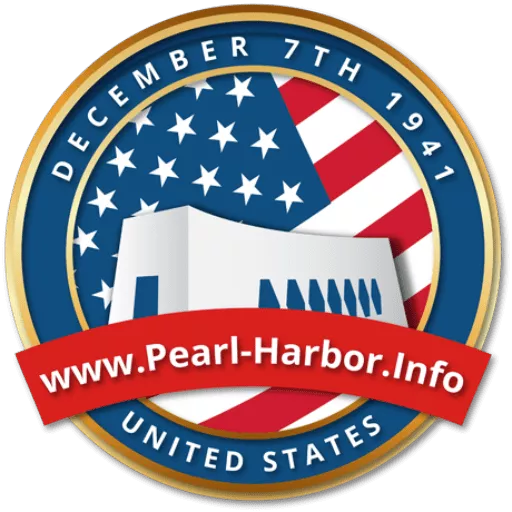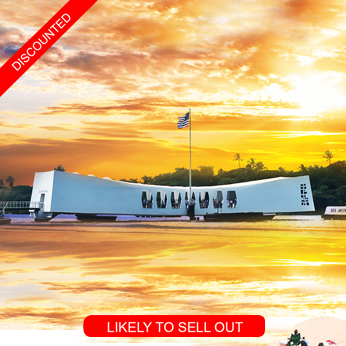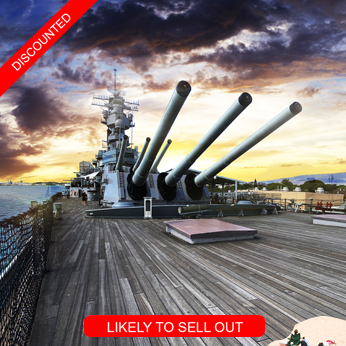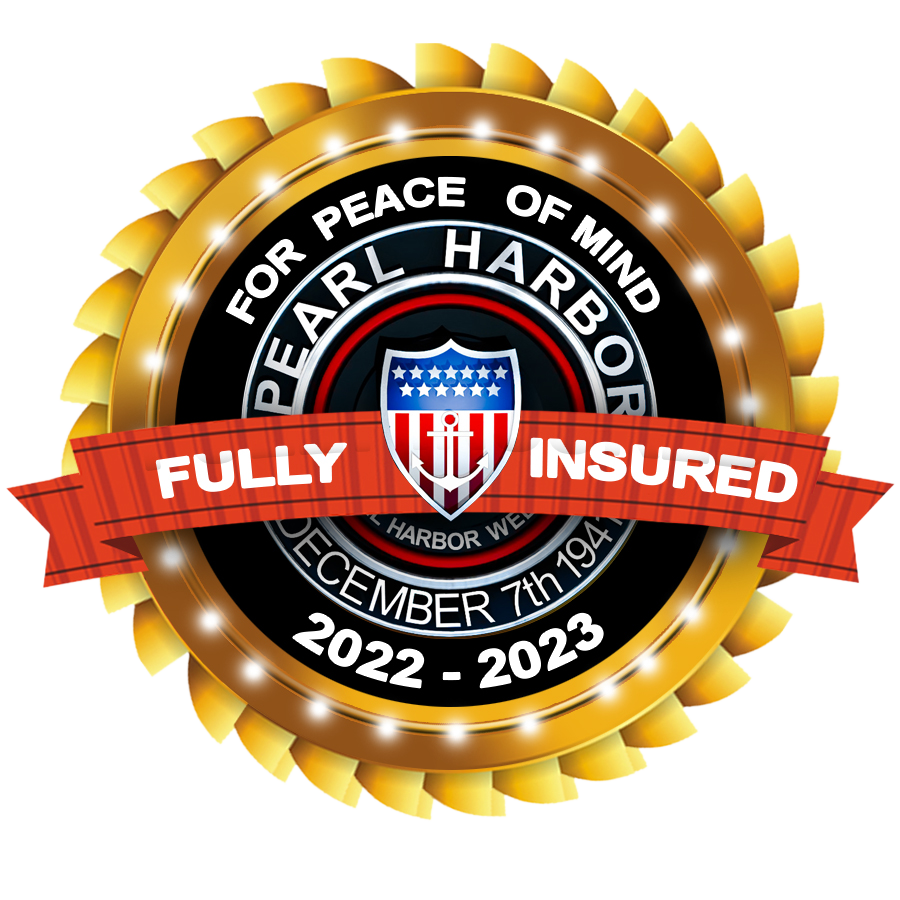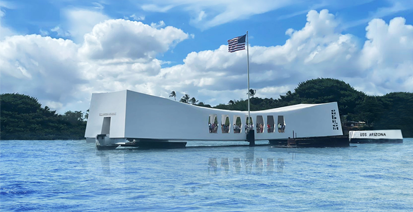Battleship Missouri
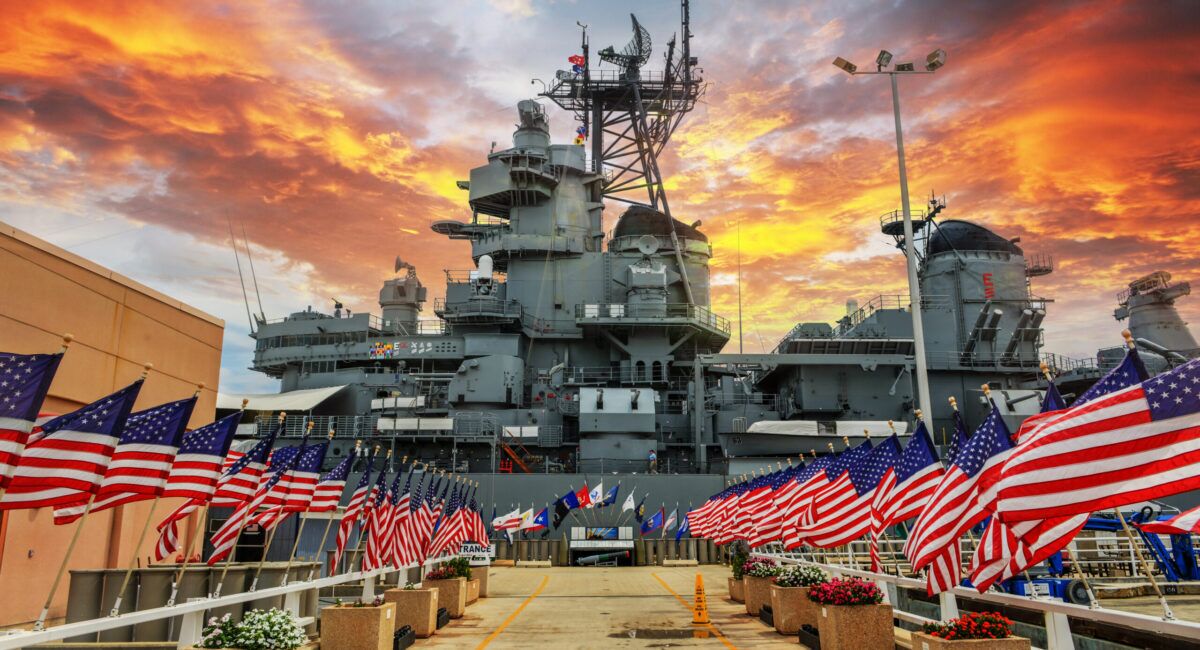
PEARL HARBOR, HAWAII - OCTOBER 6, 2012: The Battleship USS Missouri at anchor in Pearl Harbor Hawaii in 6th of October 2012.
The USS Missouri (BB-63) was an Iowa-class battleship built at the Brooklyn Navy Yard. She was launched on January 29, 1944. She was the last US Navy battleship to be commissioned. The USS Missouri displaced 58,000 tons and had a maximum speed of 32 knots, with a range of approximately 17,000 miles. Along with her three other sisters of the Iowa class, the USS Missouri was among the largest and fastest battleships built for the US Navy. She was protected with armor ranging from 11 to 19 inches thick. She was armed with nine Mk.7, 16-inch / 50 caliber naval rifles, 20 5-inch / 38 caliber dual-purpose guns, and numerous 40mm and 20mm anti-aircraft guns. Unlike earlier battleships like the battleships present at Pearl Harbor on December 7, 1941, The Iowas were fast battleships with speeds in excess of 30 knots as opposed to the 21 knots of the earlier battleships. This speed allowed them to keep up with the aircraft carriers as they stormed across the Pacific on their way to Japan. The USS Missouri is notable as being the location of the signing of the Japanese surrender at the end of WWII. The USS Missouri also served in the Korean War. She was decommissioned and stored with the mothball fleet until 1984, when she was reactivated and modernized. She received modern radar and missile countermeasures, 20mm CIWS defensive guns, RGM-84 Harpoon anti-ship missiles, and BGM-109 Tomahawk cruise missiles. She fought in the 1991 Persian Gulf war providing gunfire support for Marines and launching cruise missiles at targets in Iraq. She was even attacked by Iraqi anti-ship missiles, but they either missed or were intercepted by her escorts. The USS Missouri was decommissioned in 1992 and became a museum ship at Pearl Harbor in 1999. The USS Missouri was featured in a Cher video and several big-budget Hollywood movies such as “Under Siege”, “Pearl Harbor”, and “Battleship”.
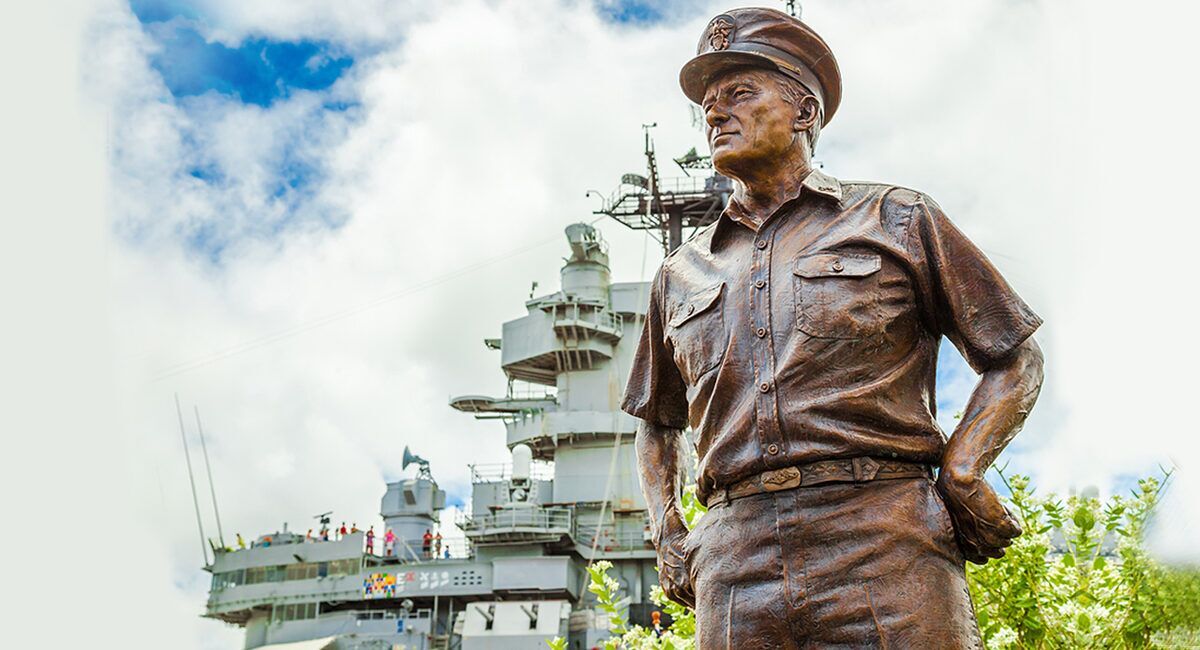
Statue of Admiral Chester W. Nimitz standing near the entrance to the USS Missouri.
Across from the Pearl Harbor National Memorial on Ford Island is the USS Missouri Battleship. When you get off the bus from the Pearl Harbor Visitor Center and enter the gate to the Battleship Missouri, you will see a bronze-colored statue of a naval officer. That is a statue of one of the most famous Admirals in US history. He is Fleet Admiral Chester W. Nimitz, who was once the Commander in Chief Pacific Fleet (CINCPACFLT). Admiral Nimitz was appointed as the head of the US Pacific Fleet after Admiral Husband E. Kimmel was relieved of command after the disaster known as the Japanese attack on Pearl Harbor on December 7, 1941. While Admiral Nimitz was in charge of what would become the largest and most powerful navy in the world by 1945, things were not so certain for Admiral Nimitz in the first few months of the war. Any future plans hung heavily on blunting the Japanese advances and allowing time for the US to build up forces for future offensive operations. While initially, the news had been grim. The Philippines had fallen, the US Asiatic fleet had all but ceased to be, and the Dutch East Indies and the British Colony of Malaya had both fallen to the Japanese. Even the tiny outpost of Wake Island, what many feared could be a stepping stone to a possible Japanese invasion of Hawaii and beyond, had fallen. But under the command of Admiral Nimitz and a host of talented subordinates, things started to turn around. The Japanese were thwarted at the Battle of the Coral Sea, securing the lines of supply and communication with Australia. The Doolittle Raid on Toyko forced the Japanese to redirect resources to defend their home Islands. Then the Battle of Midway. Admiral Nimitz’s fateful decision to listen to his intelligence analysts and make a gamble allowed the US Navy to set a trap for the Japanese. The US victory in that battle all but ended Japan’s hope for any greater advances. Admiral Nimitz and General MacArthur shared the US Navy in the Pacific. Each had his own theater, and both advanced toward Japan in parallel. That they did this with the US Government taking a Germany-first policy with the bulk of the resources going to Europe is also impressive. Admiral Nimitz favored a strategy called Island hopping, where only key Islands are invaded and taken. All others are left to “wither on the vine.” General Macarthur only had one goal. To liberate the Philippines, to keep his promise that he would return. In the end, the question of who was right is unimportant. The important part is that Admiral Nimitz and General MacArthur both stood on the deck of the USS Missouri the accept the surrender of the defeated Japanese while presiding over the largest fleet ever assembled in history.
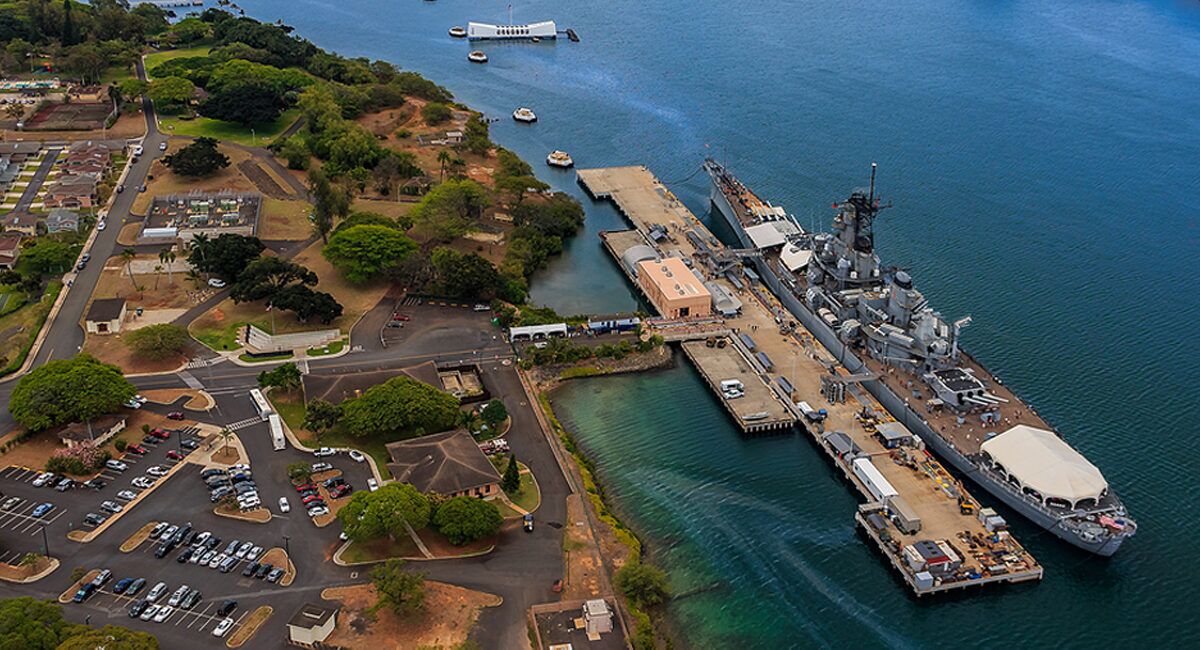
Aerial view of the USS Missouri on a calm day
There is a lot of symbolism in the US Navy. You can see it in action when you look at the USS Missouri and the USS Arizona Memorial at the Pearl Harbor National Memorial. The Battleship Missouri is facing the Arizona Memorial and the wreck of the Battleship Arizona is facing the USS Missouri Battleship. Once the decision was made to have the Missouri Battleship come to Pearl Harbor, the question of where the battleship would go was the next most important thing. There was much debate about the orientation of the USS Missouri, they did not want it to block the Arizona Memorial or somehow take away from the Arizona Memorial. Such symbolism may sound weird to some, but tradition and symbolism are ingrained in the Navy’s DNA. For example, the USS New York LPD-21 has a piece of steel from the World Trade Center incorporated in her keel. The US Navy has had two ships named USS Canberra in honor of the Australian HMAS Canberra that was lost along with a US fleet in 1942. The decision was made to have the USS Missouri in line with the USS Arizona and perpendicular to the Arizona Memorial. The Battleship Missouri would be facing the USS Arizona as if watching over it. They would also be the book ends of WWII. The Arizona Memorial represents the act that brought America into the greatest conflict in human history and the USS Missouri represents the place where that war ended.
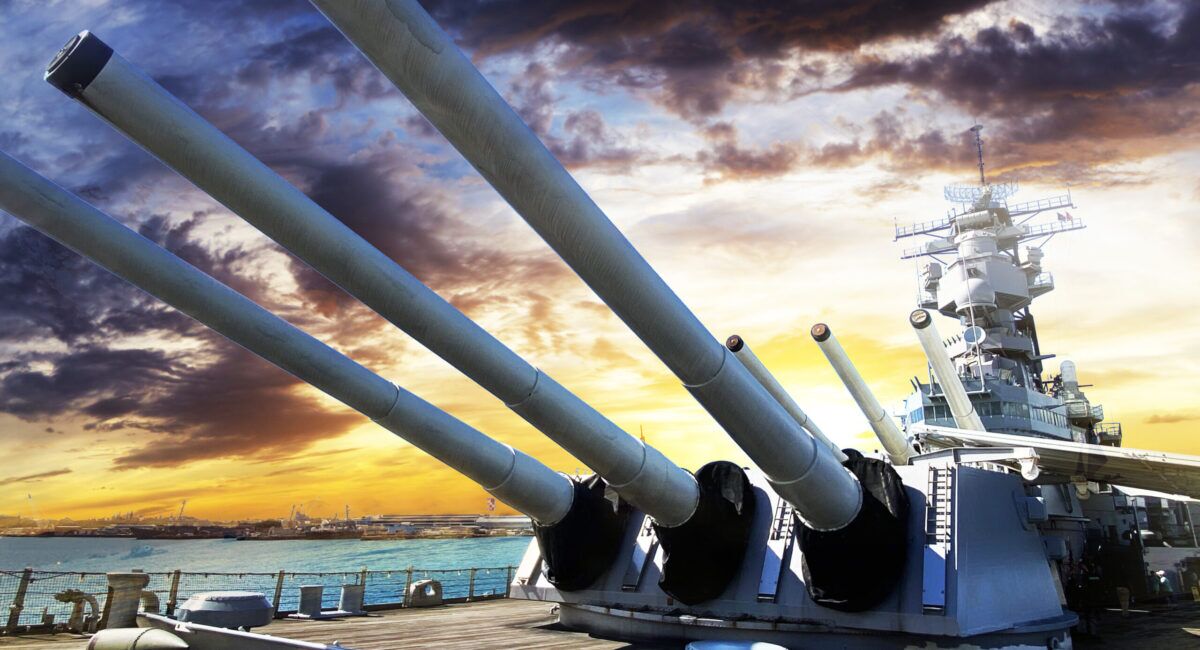
A view from the bridge of the USS Missouri on a cloudy day in Hawaii.
One thing to consider as your shuttle bus passes over the Admiral Clarey bridge headed to Ford Island from the Pearl Harbor Visitor Center heading toward the Battleship Missouri. You will notice the tranquility of Pearl Harbor. As you get off the shuttle bus at the entrance to the USS Missouri battleship, you will notice that the only really evident noise is the numerous flags fluttering in the breeze. You would be forgiven for forgetting that Pearl Harbor is a military base. The only way you would know is through the extra security and occasional glimpses of military vessels. The Missouri Battleship is quiet now. Pearl Harbor is peaceful now. Can you imagine being at Pearl Harbor on that Sunday Morning in December? The buzzing with the sound of dozens of airplane engines, soon to be punctuated but the thundering sounds of explosions and the chattering of machine gun fire. Or, for a moment, imagine what it was like to be on the USS Missouri during the invasion of Okinawa. The constant fear that the same droning sound would appear and you would have a life and death struggle with someone who wants to die trying to kill you. The earth-shattering sound of the main guns firing as they support the Allied landing. Just something to reflect on as you walk the decks of the USS Missouri Battleship in a time of peace.
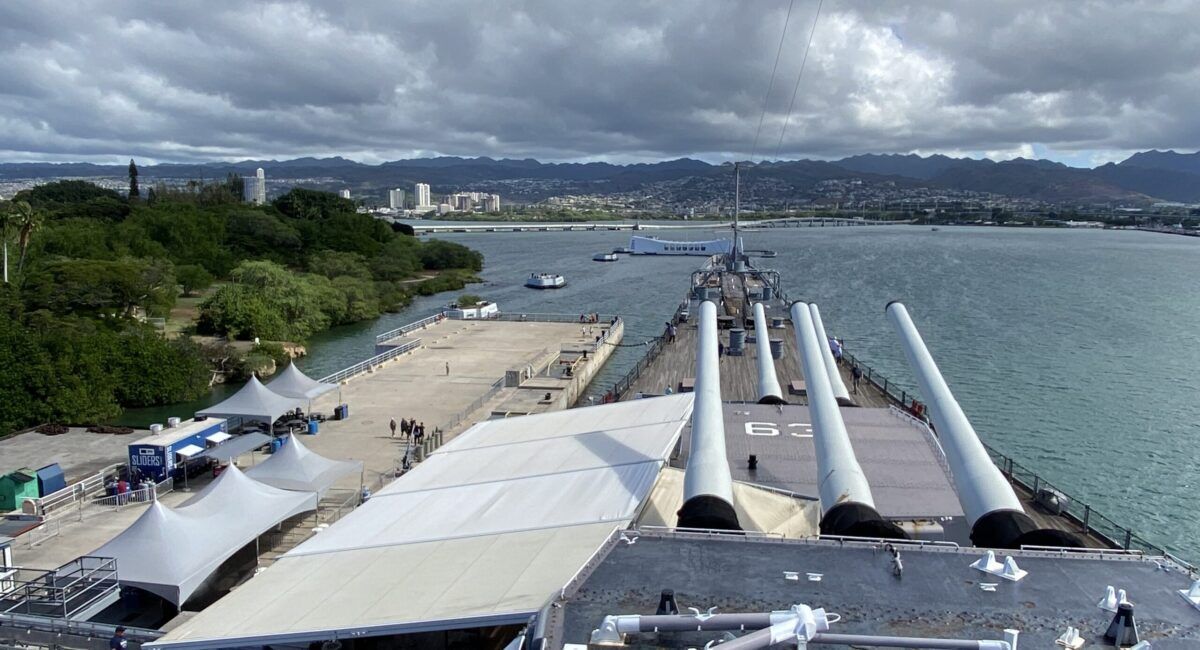
The 16-inch guns of the USS Missouri at Pearl Harbor National Memorial
Across from the Pearl Harbor Visitor Center at the Pearl Harbor National Monument is the Battleship Missouri. She is docked on Ford Island next to the USS Arizona Memorial. One of the main features of the USS Missouri Battleship are its guns. The Missouri Battleship is armed with nine 16-inch 50-caliber guns in three triple turrets. These guns were used to fire a 2,700-pound shell up to 23 miles. One shell could be fired every 30 seconds. Each gun weighed 133 tons. The turrets extended several decks below the visible part. These were ammunition stowage and hoists to get the shells to the guns. Targets could be ranged in by radar, stereoscopic range finder, spotter plane, and drones. The Iowa class Battleships such as the USS Missouri had the second heaviest broadside of any battleships ever built. First place goes to the Japanese Super Battleship Yamato. Generally, there were three types of shells that could be fired by the USS Missouri. These are high explosive, super-heavy armor piercing, and nuclear. Of those, mostly high-explosive shells were used. When the guns are fired, the decks have to be cleared. The guns firing could deafen you and the blast overpressure could be lethal if you are in the wrong place. The first time that the USS Missouri fired her guns was in support of troops landing on Okinawa. The last time her guns fired was in support of troops in the Gulf War. Today, such weapons are no longer necessary. Bombs dropped by aircraft and missiles of all types are either more efficient or cheaper to procure.

The surrender deck of the USS Missouri. A guided tour is available for those who have a ticket for the Battleship Missouri.
Once you have arrived at the Battleship Missouri on the shuttle from the Pearl Harbor Visitor Center, your tour of the historic USS Missouri can begin. But there is one problem. The Missouri Battleship is massive. Where do you start? What should you see first? What is available to see? One thing that will help you get around the USS Missouri is the guided deck tour. Included with every USS Missouri Battleship ticket is a 30-minute guided tour of the deck of the USS Missouri. As part of a group of people, you will be shown the various sights on the main deck and given narration by a professional USS Missouri guide. This is a great way to be introduced to this historic ship. This tour is optional, and you don’t have to go around with a group of people. There are brochures with diagrams of the ship as well as an audio tour is you will not be left completely on your own. But, sometimes, having a live guide to whom you can ask questions can end up being more interesting and fun than just reading the signs or listening to the audio set. What is the best way to get to Pearl Harbor and see the USS Missouri? Why not book a discounted Pearl Harbor Tour? We have a selection of group and private Pearl Harbor Tours to choose from, many of which include the USS Missouri. Spaces fill up quickly, so be sure to book your Pearl Harbor Tour as soon as possible
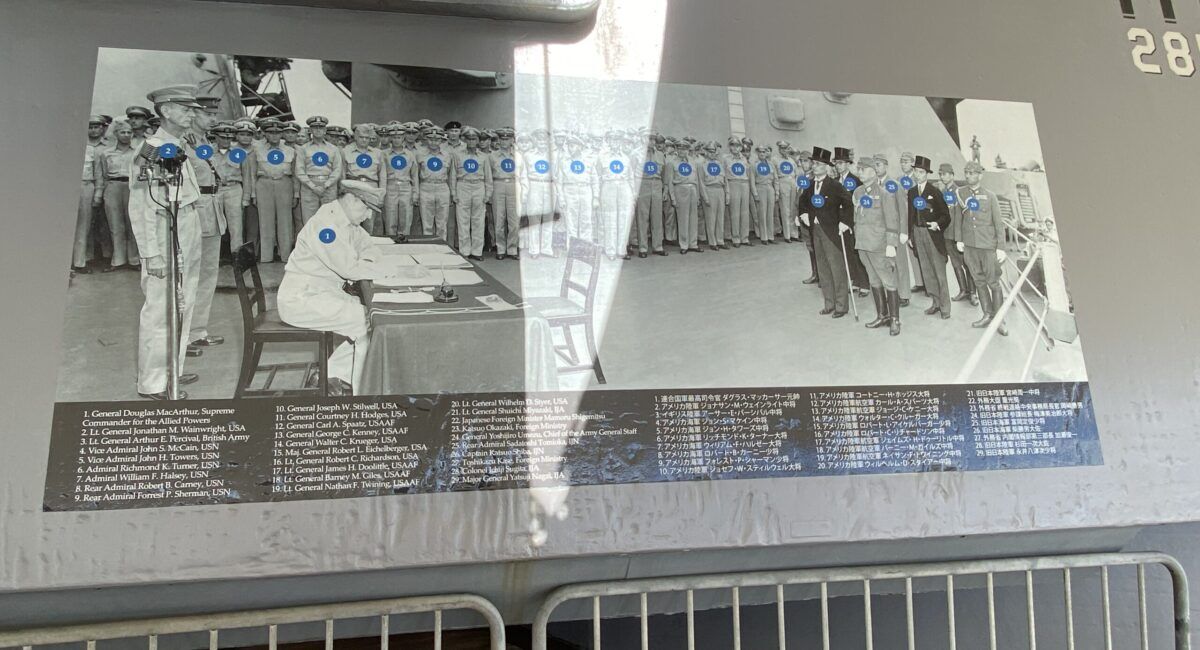
A photograph of the surrender ceremony aboard the USS Missouri is on display on turret number 2 aboard the Battleship Missouri in Pearl Harbor National Memorial.
On September 2, 1945, the Japanese formally surrendered to the Allied powers at the end of WWII. Eleven delegates representing the Empire of Japan boarded the USS Missouri in Tokyo Bay. The Allied delegation waited for them aboard the Battleship Missouri, where the ceremony was to be held. Representing the Allies were: For the United States- Admiral Chester W. Nimitz; for China- General Hsu Yung-Chang; for the United Kingdom- Admiral Sir Bruce Fraser; for the Soviet Union- Lieutenant General Kuzma Derevyanko; for Australia- General Sir Thomas Blamey, For Canada- Colonel Lawrence Moore Cosgrave, For France- General de Corps d’Armee Philippe Leclerc de Hauteclocque, For the Netherlands- Lieutenant Admiral C. E. L. Helfrich, For New Zealand- Air Vice-Marshal Leonard M. Isitt. General Douglas MacArthur signed the document as Supreme Commander of the Allied Forces. The Japanese signatories were: Mamoru Shigemitsu -On behalf of the Emperor & its Government, and General Yoshijiro Umezu, Chief of the Army General Staff. The original document is stored at the US National Archives in Washington, DC. The Japanese copy is stored at the Edo-Tokyo Museum’s archives. The area where the ceremony took place is called the surrender deck, and it is part of the 30-minute guided deck tour included with the admission for the USS Missouri.
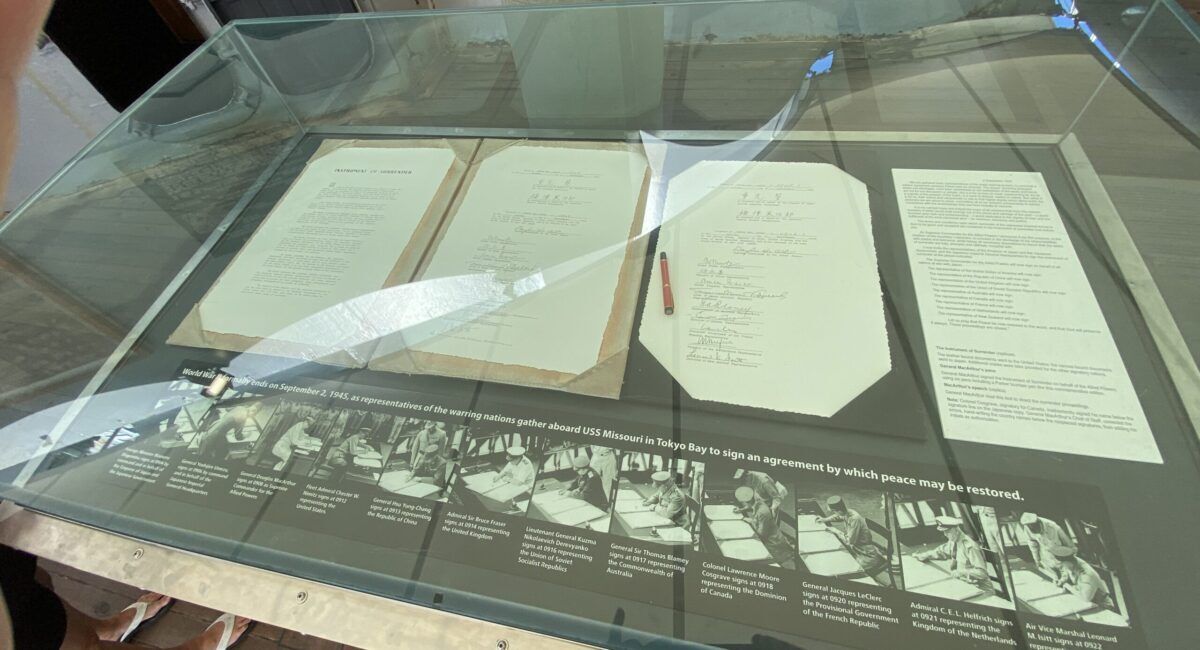
A copy of the instruments of surrender on the surrender deck display on the USS Missouri at Pearl Harbor.
One of the reasons that made Pearl Harbor the natural place for the USS Missouri to be put on display is the fact that the Battleship Missouri was the location of the Japanese surrender at the end of WWII. This matches well with the fact that the USS Arizona Memorial Monument is the location signifying the beginning of WWII. On September 2, 1945, the Japanese delegation arrived aboard the Battleship Missouri in Tokyo Bay to take part in the formal surrender ceremony to the victorious allied powers. Eleven Japanese delegates stepped aboard the USS Missouri Battleship. They were met by ten delegates representing the Allied Nations and one person as the supreme commander of all Allied forces. There is a plaque on the deck of the Missouri Battleship commemorating the Japanese surrender. The flag on display is a replica of the flag from Commodore Matthew Perry’s expedition to Japan in the 1850s. It was flown from the USS Powhatan. The flag is facing the wrong way because the original was so fragile conservationists at Annapolis, where it was on display, had sewn a backing onto it. The original was returned to the Naval Academy at Annapolis.
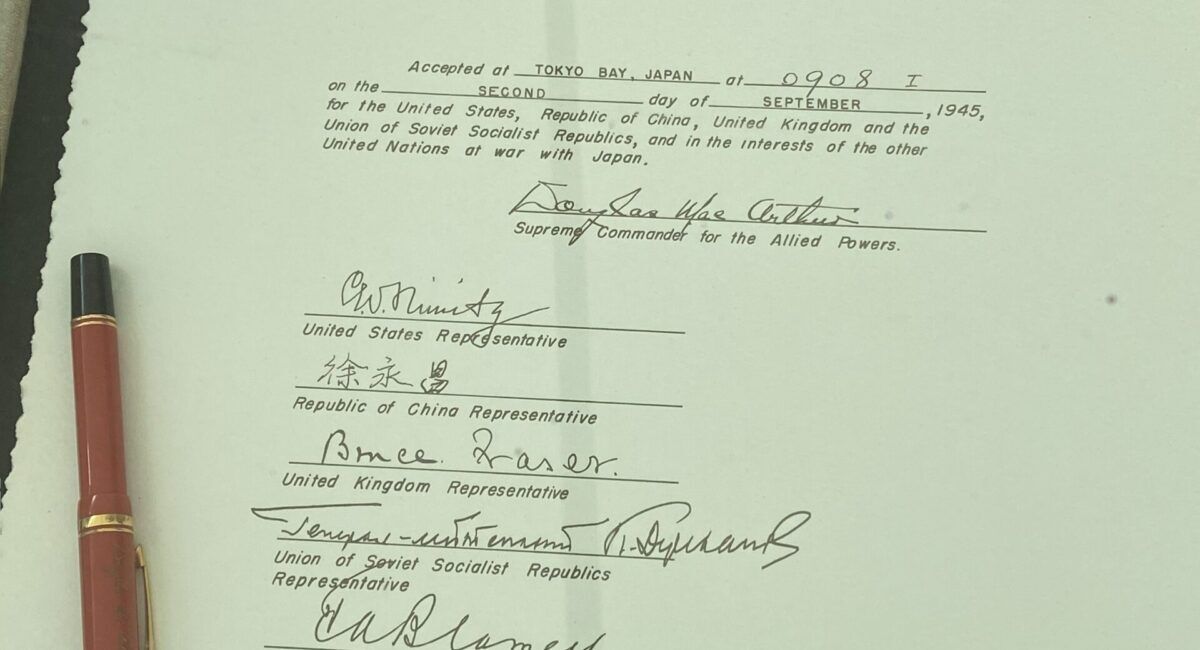
The signature page of the USS Missouri Battleship at the Pearl Harbor National Memorial.
The most well-known fact about the USS Missouri is the fact that the Battleship Missouri was the location of the Japanese surrender in 1945. That is one of the reasons that the Missouri Battleship was brought to the Pearl Harbor National Memorial. The USS Missouri Battleship has an entire part of the deck dedicated to the Japanese surrender. There is a replica of the actual instruments of surrender. The Japanese delegation was comprised of 11 people. The delegation for the Allies consisted of 10 people, each representing a different allied nation. The Allied Nations represented were The United States, the United Kingdom, Canada, Australia, New Zealand, the Republic of China, France, the Soviet Union, and the Netherlands. Admiral Chester Nimitz Signed on behalf of the United States, and General Douglas MacArthur signed as Supreme Commander of the Allied Powers. In the Allied copy of the instruments of surrender, the Canadian delegate Colonel Lawrence Moore Cosgrave signed on the wrong line owing to the fact that his vision had been damaged by poison gas during WWI. The proceedings were halted until the signatures were straightened out. The Original Allied copy is stored at the US National Archives. The Japanese copy is housed in the Edo-Tokyo Museum archives.
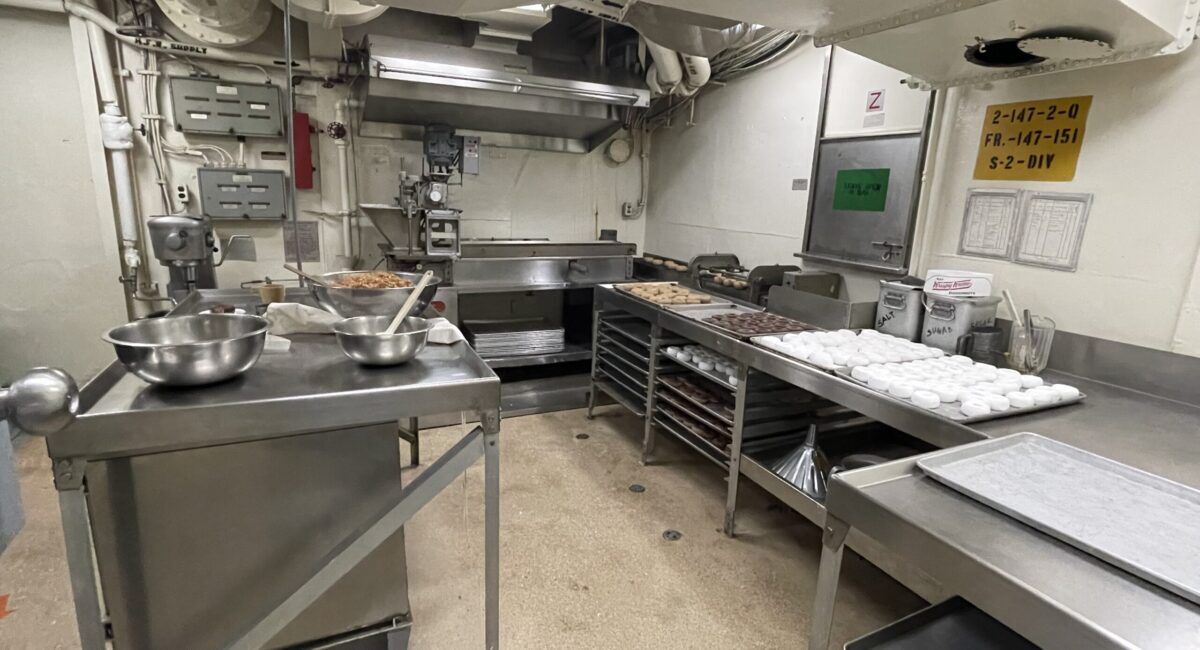
The galley for the enlisted mess aboard the USS Missouri Battleship located in the Pearl Harbor National Memorial
The galley aboard a warship is one of the most important places. As Napoleon once said, ” An army marches on its stomach.” This is as true now as it was then. The galley aboard the USS Missouri is large, and it needs to be to accommodate meal preparation for thousands of people each day. Recipes for menu items were measured in bags and tubs meant to feed hundreds at a time. In modern times, American servicemen can expect their meals to be of decent quality as long as supply lines keep moving steadily and uninterrupted. While the officers had food of a better quality, there was not as much of a difference as would be found in the meals of other nations during WWII. The United States had one of the strongest and largest logistical systems of any of the belligerents during WWII. Captured American rations were considered a treat, especially later in the war when enemy supply lines were either crippled or nonexistent. All this is to say that American servicemembers in WWII were, for the most part, well-fed. American soldiers were even well-supplied with luxuries like Coca-Cola and ice cream. The one thing Americans lacked was alcohol. The US Navy was a dry Navy.
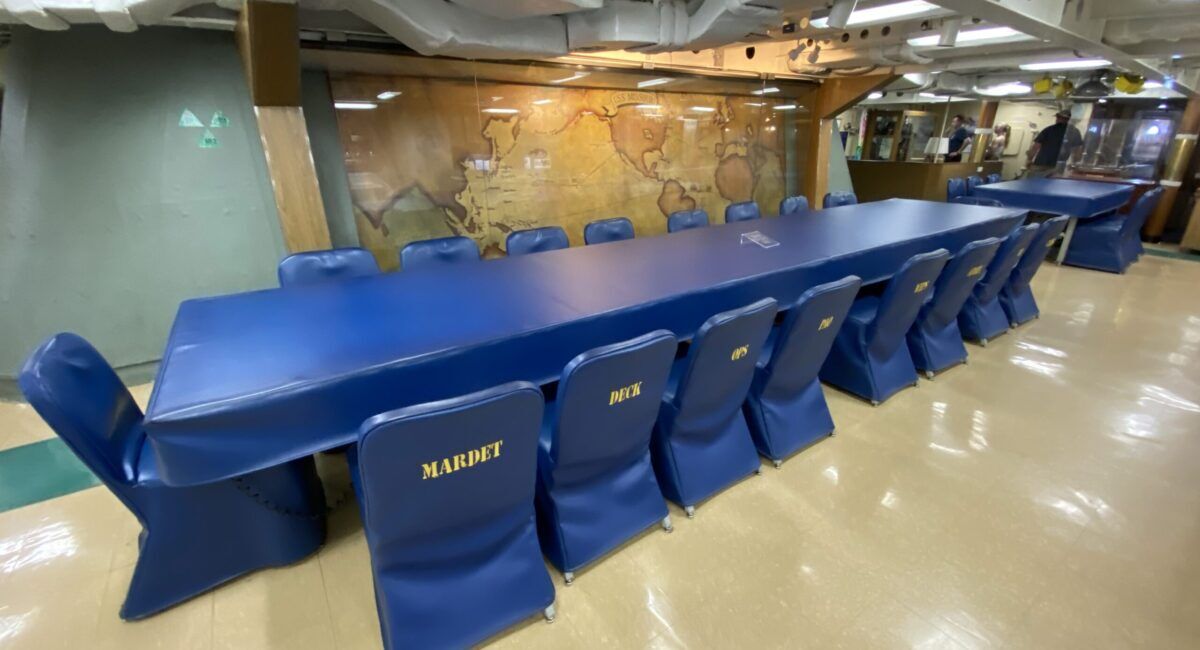
The wardroom of the USS Missouri at Pearl Harbor. This is the officers' dining area.
The dining area for the enlisted men aboard the USS Missouri or aboard any ship is spartan compared to the wardroom. The enlisted men’s mess hall was where almost all meals were served for the enlisted crew of the Battleship Missouri. With over a thousand people to feed, meals were served in shifts. The food quality overall was good, especially in the Navy, as they had constant access to actual kitchens, which were not always available to those in the field. One thing in constant supply in the Navy, especially on larger ships like the USS Missouri Battleship, was ice cream. Ice cream was a major comfort food for servicemembers in all branches during WWII. The US military was a dry military with no alcohol. Instead, the United States heavily invested in the production capacity and refrigeration necessary for a steady supply of ice cream. In fact, the US Navy had an ice cream barge that could manufacture 10 gallons of ice cream every seven minutes. This barge was forward deployed and was, for a time, anchored in Ulithi Atoll, a major US Navy fleet base. The ice cream barge was probably the best-defended barge in the US Navy. Rumor has it that when the Japanese learned of the existence of an entire ship dedicated just to making ice cream, they understood that they could not possibly hope to win.
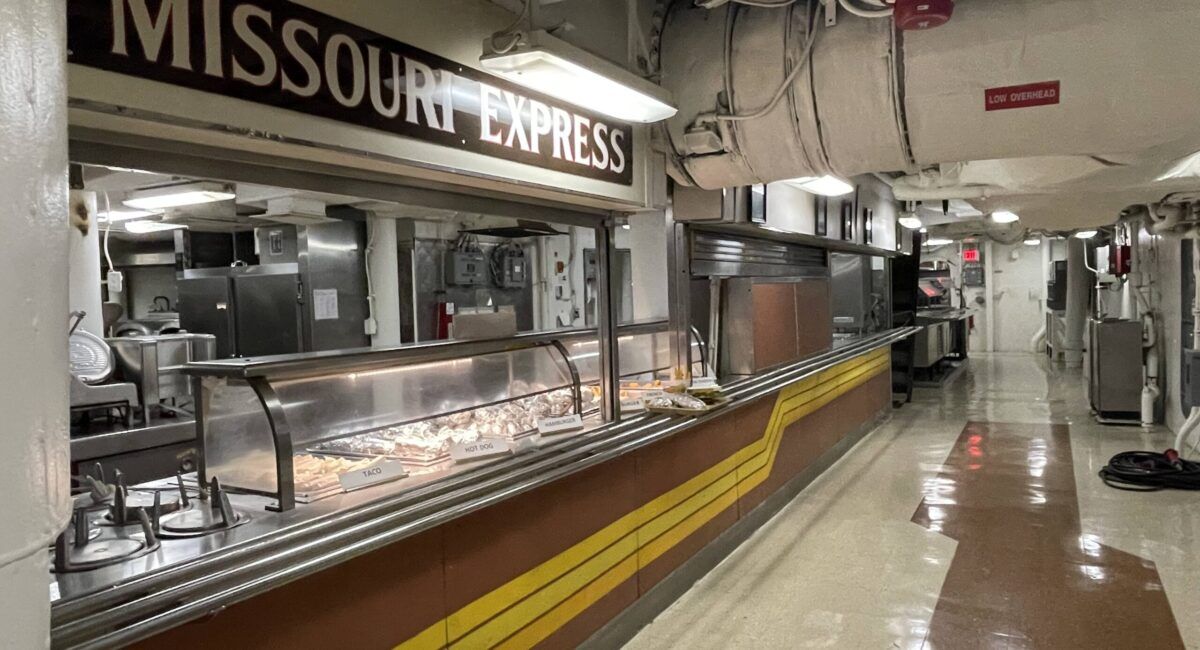
One of the highlights of any tour of the USS Missouri is getting to see the crew areas. The wardroom or officers’ mess is one such place. Unlike the enlisted mess room, the wardroom is well-appointed. This space is not only the officers’ dining area but is also used for special occasions. There is a special etiquette regarding the behavior of the officers in the wardroom. Usually, the most senior is asked permission by the junior officers to sit at the table. The president of the wardroom is traditionally the ship’s executive officer. The captain is not part of the mess. He has his own mess area. If he wants to dine in the wardroom, the captain usually asks for permission from the president of the wardroom. Generally, talk of politics, religion, or sex is not allowed while dining in the wardroom. Talking about work-related subjects is also looked down upon. The wardroom of the Battleship Missouri also includes a lounge and kitchen. If you have a very special occasion to celebrate, the USS Missouri Battleship’s wardroom is available to rent out. The capacity is 55 people. Events have to be held in the evening after normal operating hours. For details, contact the USS Missouri.
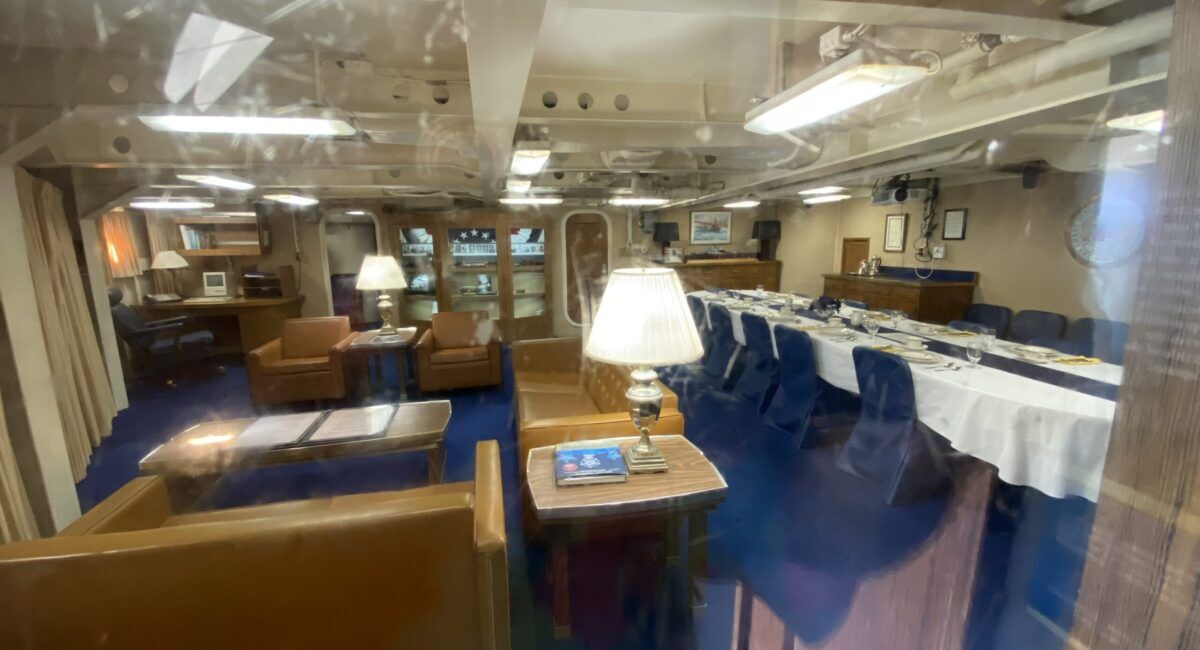
The Captain's cabin on the USS Missouri at Pearl Harbor
The wardroom is the dining area for officers aboard the battleship Missouri. The Captain of the USS Missouri has his own cabin with a dining area. The Captain’s cabin is viewable but is not part of the normal Missouri Battleship tour. This room is the most historic room on the USS Missouri battleship in the sense that it is filled with artifacts from the USS Missouri’s long history. Over its long career, the USS Missouri has had 23 commanding officers. Actually, 20 different commanding officers, as three of them served as Captain twice. Captain Stuart S. Murray was the Captain during the Japanese surrender. Captain William M. Callaghan was the Captain that ordered the formal burial at sea for the Japanese pilot that crashed into the USS Missouri. Interestingly, Captain Albert Lee Kaiss not only served as Captain twice, but he was also the commissioning Captain when the USS Missouri was recommissioned in 1986 and was the Captain when the USS Missouri was decommissioned in 1992. As he was the last to step off of the USS Missouri at the end, he is also the last battleship sailor in the World. The Captain’s Cabin on the USS Missouri may be reserved for special occasions. The capacity is 25 people. For details, contact the USS Missouri.
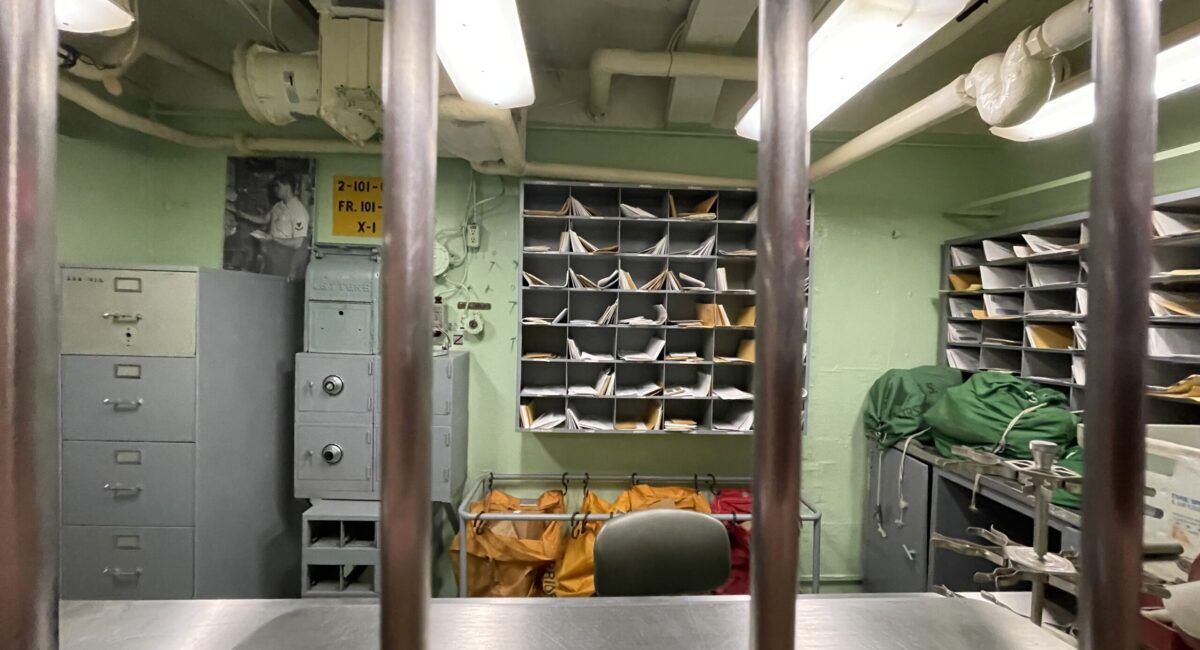
The mail room aboard the Battleship Missouri at the Pearl Harbor National Memorial
Logistics is one of the main reasons the Allies won the second World War. The steady stream of supplies and equipment is the key to the success of any military. One factor that must not be overlooked is morale. One of the ways to keep morale up is a regular delivery of letters from home. It reminds the sailors that there is someone waiting for them at home, be it family, friends, or sweethearts. Good morale is an important factor in any victory, as an army with terrible morale can be defeated with little effort. The call home has long since replaced paper mail, but during WWII, written letters were the only form of communication widely available to soldiers and sailors. A ship the size of the USS Missouri with thousands of Sailors and Marines required a sizable effort to sort through the various packages and letters destined for the servicemen. Then there was the matter of thousands of letters from the front lines going back to the United States. During WWII, mail was delivered to ships at sea by either ship assigned specifically for that task or by combat support ships that delivered fuel, ammunition, or food, as well as mail.
Most Popular Oahu Tours
Best Pearl Harbor Tours – NOW ON SALE

The following tours are recognized as the most popular Pearl Harbor Tours on Oahu. While generally, our price is the lowest in the market now, for a limited time, they are on sale too.
